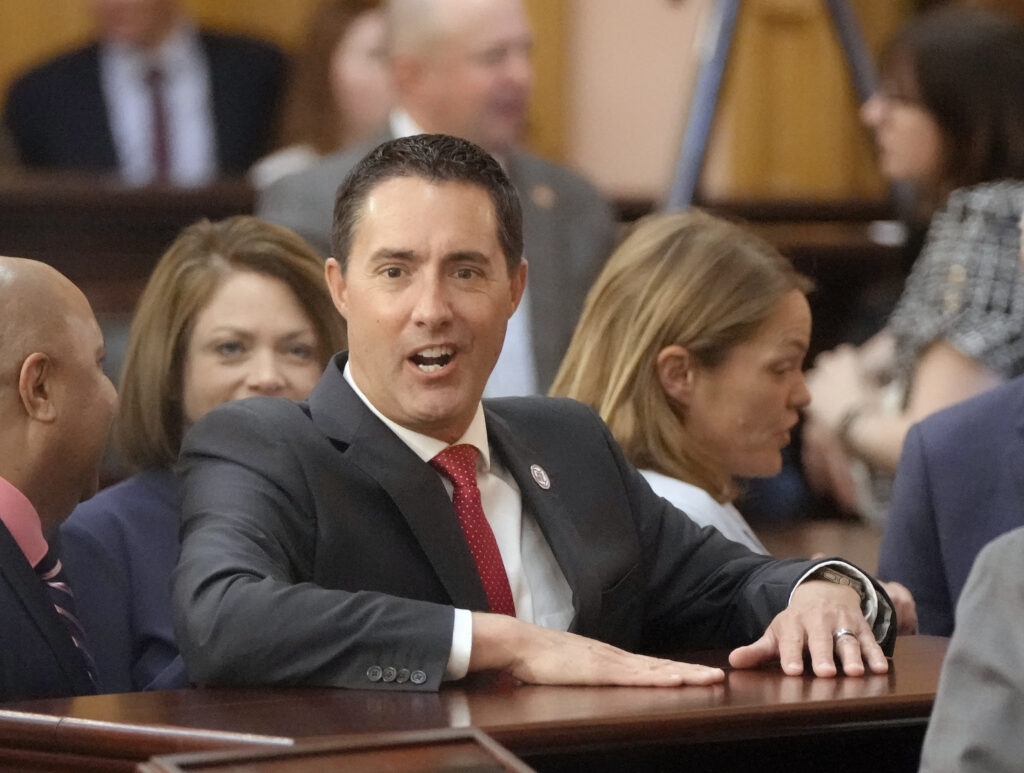Ohio Secretary of State Frank Larose mingles before the 2024 State of the State address in the Ohio House chambers at the Ohio Statehouse. (Pool photo by Barbara J. Perenic, Columbus Dispatch.)
Ohio Secretary of State Frank LaRose has provided an announcement on election integrity “exclusively” to anti-abortion Ohio Right to Life, the group said in a Monday press release. It contains a link to a YouTube video in which LaRose talks about how Ohio elections are safe because the nuts and bolts of the process are overseen at the local level by officials from both parties.
LaRose’s office didn’t respond to questions for this story.
In the video, the secretary of state repeated his saying that in Ohio, “it’s easy to vote and hard to cheat.” And he lays out several reasons why it’s hard at least for voters themselves to cheat.
LaRose explains that county boards of election are each run by two Republicans and two Democrats and that voting machines are “airlocked,” meaning they’re never connected to the internet and thus not vulnerable to hacking. LaRose added that even access to the machines has to be on a bipartisan basis.
“The voting machines are under bipartisan surveillance and they’re kept in a storage system with dual locks and keys that require a Republican key to open the door and a Democratic key to make sure that both parties are present,” he said.
The candidates, the ballot measures, and the tools you need to cast your vote.
LaRos later added, “We take election integrity seriously here in Ohio.”
By LaRose’s own reckoning, just 0.0005% of the ballots cast in Ohio’s 2020 presidential election were “potentially illegal.” Meanwhile, LaRose has also argued that former President Donald Trump had a legitimate point about voter fraud.
As of last year, LaRose had forwarded 521 cases of possible noncitizen voting for prosecution over five years. That resulted in just one prosecution for voter fraud.
In addition, in the video he recorded for Right to Life, LaRose said that audits comparing electronic vote results to paper backups have been correct more than 99.9% of the time since he took office at the beginning of 2019.
Despite the lack of a statistical case that there’s a problem, LaRose has taken aggressive steps that he says will protect election integrity.
For example, he’s purged hundreds of thousands of Ohioans from the registration rolls. Many were eligible voters who were purged for not voting in recent cycles even though critics point out that there’s no constitutional basis to argue that just because a citizen hasn’t voted in some past elections he or she is ineligible.
A progressive watchdog group, Dēmos, found that LaRose’s office has some of the worst practices for ensuring that eligible voters aren’t improperly purged from the Ohio rolls. And civil rights advocates say Ohio’s purges disproportionately target voters of color, who tend not to vote for the GOP, LaRose’s party.
On the issue of citizen-proposed constitutional amendments, as chair of the Ohio Ballot Board, LaRose has significant control over the description of an amendment that appears on the ballot — in other words, what voters read when they enter the voting booth.
He’s under intense fire this year for the language he used to describe the Issue 1 amendment aimed at removing elected officials from the process of drawing maps of Ohio’s legislative and congressional districts in favor of a citizens commission.
In 2021 and 2022, LaRose and the other Republicans on the Ohio Redistricting Commission ignored seven bipartisan rulings by the Ohio Supreme Court that said the maps they drew violated earlier anti-gerrymandering amendments that were passed by huge majorities of Ohioans.
The proposed amendment that will appear on the November 2024 ballot is meant to be more water-tight than the earlier ones by removing politicians from the process, replacing them with citizens, and retaining a ban on partisan gerrymandering. But LaRose wrote ballot language that opponents say is intended to sway voters against the amendment, which LaRose publicly opposes.
Last year, LaRose was similarly accused of manipulating ballot language against Ohio’s reproductive rights amendment when he consulted with Ohio Right to Life and other anti-abortion groups in drafting the ballot language. Nevertheless, Ohio voters passed the reproductive rights amendment by 14 points.
YOU MAKE OUR WORK POSSIBLE.

